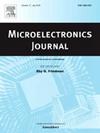一种用于大规模天线阵列的功率迭代波束形成器
IF 1.9
3区 工程技术
Q3 ENGINEERING, ELECTRICAL & ELECTRONIC
引用次数: 0
摘要
大规模天线阵列波束形成是实现高频通信的技术之一。由于空间协方差矩阵的高维,算法计算和控制逻辑的复杂性急剧增加,从而导致相关的计算开销,这是扩大天线阵列从而提高波束形成性能的主要障碍。本文提出了一种适合大规模天线阵列应用的基于功率迭代的波束形成算法及其硬件实现。一般情况下,幂迭代法收敛速度较慢。然而,我们发现慢收敛对波束形成性能的影响很小。这使得波束形成算法的无收敛终止成为可能,从而有助于显著降低计算复杂度。在处理大规模天线阵列时,利用数据固有的厄米对称特性进行内存压缩,使存储成本降低了近一半。同时,为并行数据访问提供了专用寻址方案,避免了内存冲突。我们的设计采用22nm CMOS技术,支持32至1024个天线元件,在4.97 mm2的面积内集成6277K栅极,在600MHz时功耗为159 mW。它在支持大规模天线阵列的可扩展性方面优于最先进的结果,并且还可以实现高能效。本文章由计算机程序翻译,如有差异,请以英文原文为准。
A power-iteration-based beamformer for large-scale antenna arrays
Beamforming with a large-scale antenna array is one of the enabling techniques for communications in high frequencies. The related computational overhead, which arises from the sharply increased complexity of algorithmic computation and control logic due to the higher dimension of the spatial covariance matrix, is a major impediment to scaling up the antenna array and thereby improving beamforming performance. This paper presents the power-iteration-based beamforming algorithm and the hardware implementation that are well suited for the applications to large-scale antenna arrays. In general, the power iteration method converges slowly. However, we find that the slow convergence has minimal effect on the beamforming performance. This fact enables convergence-less termination of the beamforming algorithm, and hence contributes to significant reduction in the computational complexity. To deal with large-scale antenna arrays, the inherent data Hermitian symmetry property is also utilized for memory compression, reducing the memory cost nearly by half. In the meantime, the dedicated addressing scheme is provided for parallel data access without memory conflict. Our design is layouted in a 22-nm CMOS technology, supporting 32 to 1024 antenna elements, integrating 6277K gates in an area of 4.97 mm2, and dissipating 159 mW at 600MHz. It outperforms the state-of-the-art results in the scalability to support large-scale antenna arrays, and can achieve high energy efficiency, too.
求助全文
通过发布文献求助,成功后即可免费获取论文全文。
去求助
来源期刊

Microelectronics Journal
工程技术-工程:电子与电气
CiteScore
4.00
自引率
27.30%
发文量
222
审稿时长
43 days
期刊介绍:
Published since 1969, the Microelectronics Journal is an international forum for the dissemination of research and applications of microelectronic systems, circuits, and emerging technologies. Papers published in the Microelectronics Journal have undergone peer review to ensure originality, relevance, and timeliness. The journal thus provides a worldwide, regular, and comprehensive update on microelectronic circuits and systems.
The Microelectronics Journal invites papers describing significant research and applications in all of the areas listed below. Comprehensive review/survey papers covering recent developments will also be considered. The Microelectronics Journal covers circuits and systems. This topic includes but is not limited to: Analog, digital, mixed, and RF circuits and related design methodologies; Logic, architectural, and system level synthesis; Testing, design for testability, built-in self-test; Area, power, and thermal analysis and design; Mixed-domain simulation and design; Embedded systems; Non-von Neumann computing and related technologies and circuits; Design and test of high complexity systems integration; SoC, NoC, SIP, and NIP design and test; 3-D integration design and analysis; Emerging device technologies and circuits, such as FinFETs, SETs, spintronics, SFQ, MTJ, etc.
Application aspects such as signal and image processing including circuits for cryptography, sensors, and actuators including sensor networks, reliability and quality issues, and economic models are also welcome.
 求助内容:
求助内容: 应助结果提醒方式:
应助结果提醒方式:


